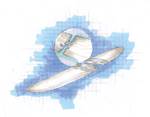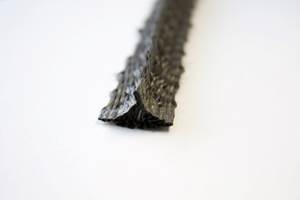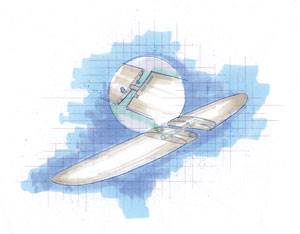Tougher surfboards and stand-up paddleboards
High-modulus polypropylene fiber cuts board weight and dramatically increases damage tolerance.
Composites Technology spills a fair amount of ink covering the efforts of composites manufacturers in dozens of end-markets to improve their products with new materials. But surfboard manufacturers are rarely among them. The surfboard market is uniquely resistant to materials innovations, explains Roy Scafidi, owner of Island Surfboards and Oceansports World (Cocoa Beach, Fla.) “because manufacturers don’t like to change. Once they get something to work, they like to stick with it.”
To that rule, Scafidi is a notable, and therefore newsworthy, exception (but see end note, below). Using a recently developed high-modulus polypropylene (HMPP) fiber, Scafidi has modified previous all-glass designs used in his surfboards and his increasingly popular stand-up paddleboards (SUPs). The result, he says, is no mere novelty. “We’ve made over 200 surfboards and SUPs over the past 18 months with extremely good results,” Scafidi reports. “We haven’t had one failure, which is truly remarkable. With our normal glass/epoxy boards, we would have seen at least a few failures, simply due to the abuse they take.”
Substitutionary tailoring
The HMPP fiber, developed by Innegrity LLC (Simpsonville, S.C.) and sold under the trade name Innegra, was introduced to the composites market in 2006 and entered full-scale production earlier this year at a 120,000-ft² (11,150m²) facility outside of Greenville, S.C. Innegra fiber density is roughly half that of aramid and carbon fibers, and 30 percent the density of E-glass fiber. Combined with a cost that is roughly half that of carbon, Innegrity has marketed its composite reinforcement not as a standalone material, but as a replacement for other fibers in one or more layers near the center of a solid laminate or next to the core of a sandwich composite, where it offers reduced weight and increased toughness at a reasonable cost.This strategy is a good fit for high-performance surfboards and SUPs. These boards start with a shaped foam core, or blank, of expanded polystyrene (EPS) foam of low density (e.g., 2 lb/ft³). Scafidi explains that he does not use extruded polystyrene (EPS) foam, because it outgasses over time and can disbond the skins. The blank is laminated, top and bottom, with multiple plies of lightweight cloth — 2, 4 or 6 oz/yd² — and epoxy resin. According to a construction primer by Stand Up Paddle Surfing Magazine, “A super light glass job for a stand up paddle board would be one layer of 4 oz on the bottom and a layer of 6 oz and 4 oz on the top.” A heavier glass job is described as having two layers of 6 oz glass on the bottom and three layers of 6 oz on top. The primer advises, “Lighter glass jobs will be more lightweight and may have a little more flex to them, while heavier glassed boards are more durable and stiff.”
“In order to keep weight down using fiberglass, board manufacturers try to reduce fiber, which results in low durability,” observes Innegrity’s business development manager Mark Shioleno. This is a bigger issue for the longer, wider and thicker SUPs. Scafidi’s Island Surfboards builds SUPs ranging in length from 7 ft, 11 inches (2.4m) to 14 ft (4.3m), with widths between 30 and 33 inches (762 and 838 mm), and varying in thickness from 4 to 5 inches (102 to 127 mm), depending on whether they are primarily used for surfing (shorter and thinner) or cruising in lakes and rivers (longer and thicker).
Optimizing ply placement
Shioleno says that by using Innegra against the foam core, under the glass skin, surf and SUP board makers can add fiber back in and still cut weight. “But we’re not the primary laminate reinforcement,” Shioleno observes. “We’re secondary to the glass or carbon, adding toughness and other benefits.” Lewis Dyer, technical sales support at Innegrity, claims that riders report Innegra boards offer a smoother, more responsive ride. “The fiber also acts as a vibration damper, taking a lot of the chatter out of the board,” says Dyer.
Hank Johns, co-owner of Graphite Master, a Los-Angeles-based composite materials supplier to the surf industry, and board member of the Surf Industry Manufacturers Assn. (SIMA, Aliso Viejo, Calif.), says, “A surfboard’s flex and re-flex are what surfers feel on the face of the wave. Innegra’s significant property for surfboards is its dynamic tenacity.”
Accordingly, Scafidi is replacing several layers of 6-oz fiberglass fabric with one ply of 3.5-oz, 100 percent Innegra plain (flat) weave fabric, which he says works well in complex curves. Acknowledging that some board makers have complained that HMPP is hard to wet out with resin, difficult to conform around rails (the edges of the surfboard that run from nose to tail) and a nightmare to sand, he notes, “We are a pretty technical shop, and are used to working with high-tech materials, so we understand the wet-out might be a little bit different, but it hasn’t really been a problem for us.” (Shioleno and Dyer point out that it is possible to get good resin encapsulation with Innegra and epoxy, but the fiber may not look wet out because it does not turn translucent like impregnated glass.) Scafidi’s shop also uses vacuum bagging in its room-temp-cure wet layup process, which eliminates conformability issues. Placing HMPP fiber near the core not only optimizes laminate performance but also avoids issues with sanding.
“Innegra is a little more expensive than fiberglass,” Scafidi notes, “but we’re replacing multiple glass layers, so the expense is offset somewhat.” Innegrity claims that, on average, surf/SUP board manufacturers are cutting 2 to 3 lb (0.91 to 1.36 kg) per board, a roughly 10 percent weight savings. For carbon fiber-reinforced boards, similar use of HMPP fibers reportedly can reduce the need for carbon by more than 30 percent, while building thickness, which exponentially increases stiffness and reduces both weight and overall cost. Scafidi contends that standard composite testing, using ASTM (West Conshohocken, Pa.) test methods, indicates that this board construction is 40 percent stronger than a fiberglass-only construction.
Based on what he’s seen so far, supplier Johns says Graphite Master has committed to marketing HMPP. “We will be investing a lot in this technology and believe Innegra can represent a paradigm shift in custom board design.”
Beyond the boards
Because the performance drivers are similar, Innegrity believes its fiber also will increase damage tolerance and reduce weight in wind-surfing boards, skimboards, snowboards and skateboards. According to SIMA, surf and skate hardgoods (boards) totaled $1.1 billion in sales in 2008. Additionally, ski and snowboard sales topped $760 million in 2008, according to the SnowSports Industries of America (SIA, McLean, Va.). Snowboard and ski sales were estimated at 1.25 million units and 4 million units respectively in 2007. Thus, the potential future market for Innegra fiber in board sports is well worth pursuing.Scafidi agrees. As a distributor of Innegra fabrics via Oceansports World, he’s exploring the potential, and already has sent samples of Innegra fabric not only to manufacturers of kayaks, SUP paddles, snowboards and hockey sticks but also to a fabricator of Chevrolet Corvette car parts.
Editor's note: The surfboard industry’s resistance to change was strikingly illustrated by the panic among board shapers following by the abrupt closure of the industry’s prime source of foam core, an event that forced an unusual period of experimentation with alternative foams that may have opened the door to fiber innovation (see the first article listed under "Editor's Pick's," at right.) Another exceptional break from traditional baord design is the two-piece, hollow carbon-fiber reinforced composite “travelboard” detailed in "Have surfboard, will travel," listed at right.
Related Content
Composite resins price change report
CW’s running summary of resin price change announcements from major material suppliers that serve the composites manufacturing industry.
Read MoreBiteam introduces 3D Noodle International AB spin-off for 3D fabric noodles
Biteam 3D’s third spin-off implements its proprietary 3D weaving technology to produce a variety of carbon, ceramic and other fiber 3D fabric noodle preforms.
Read MoreCAMX 2022 exhibit preview: Parabeam
Parabeam’s 3D E-glass woven fabrics, particularly ParaGlass and ParaTank, continue to advance composite sandwich structures with high flexibility, strength and application versatility.
Read MoreMaterials & Processes: Fabrication methods
There are numerous methods for fabricating composite components. Selection of a method for a particular part, therefore, will depend on the materials, the part design and end-use or application. Here's a guide to selection.
Read MoreRead Next
Engineering Insights: Have Surfboard, Will Travel
This two-piece surfboard for the world traveler clamps together for seamless world-class performance.
Read MoreWaves Of Change: From Shock To Opportunity
Closing of Clark Foam opens surfboard industry to new technologies.
Read MoreFrom the CW Archives: The tale of the thermoplastic cryotank
In 2006, guest columnist Bob Hartunian related the story of his efforts two decades prior, while at McDonnell Douglas, to develop a thermoplastic composite crytank for hydrogen storage. He learned a lot of lessons.
Read More































